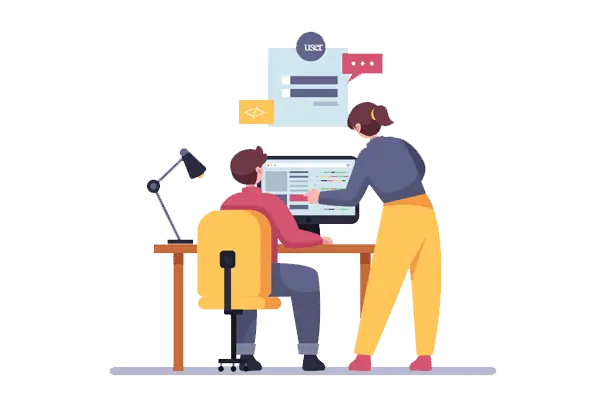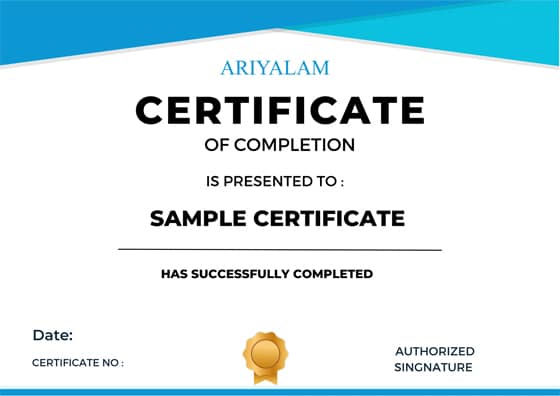Python Course Online
Ariyalam offers the best Python course online, specially designed for both beginners and professionals. Whether you are located in Bangalore, Chennai, Coimbatore, or Madurai, you can easily learn Python from the comfort of your home through our interactive online live classes.
This Python training course takes you from zero to expert level, covering everything you need to become a skilled developer. You’ll learn Python programming, the Django framework, Data Science, and Machine Learning through real-time projects and hands-on experience.

Key Features
Python Training Certificate

Key Features
Python Training Certificate

Python Course Prerequisites:
Before you start our Python Course Online, it’s helpful to know basic computer skills like managing files, browsing the internet, and typing efficiently. A basic understanding of math concepts such as variables and logic will make learning easier.
No prior programming experience? No problem! Our course is designed for beginners — you’ll learn everything from scratch, including loops, functions, and hands-on projects.
Our online Python course for beginners is available across India — whether you’re looking for Python training in Bangalore, Python course in Coimbatore, or Python training in Madurai. You can also explore our Python and Django course or full-stack Python developer course for advanced learning.
Join our best Python course online today and get certified as a skilled Python programmer. Whether you’re a student, job seeker, or working professional, this course will help you build a strong foundation in programming and open doors to exciting tech careers.
Python Course Syllabus
Module 1: Introduction to Python
- What can Python do?
- Why choose Python?
- Key things to know
- Python syntax vs other programming languages
- Installing Python
Module 2: Python Basics
- The print statement
- Comments in Python
- Data structures and types
- Working with strings
- Input and output in Python
- Simple output formatting
- Operators in Python
Module 3: Python Program Flow
- Indentation in Python
- Using the if statement
- Example of if and related statements
- while loop
- for loop
- range function
- break and continue
- Using assert
- Examples of loops
Module 4: Functions and Modules
- Creating functions
- Function parameters
- Working with variable arguments
- Scope of a function
- Documenting functions
- Lambda functions and map
- Exercises with functions
- Creating a module
- Standard Python modules
Module 5: Exception Handling
- Types of errors
- Using try for exception handling
- Handling multiple exceptions
- Creating your own exceptions
Module 6: File Handling
- File modes (read, write, etc.)
- Adding Filters and Drill Features
- Reading and writing files
- Appending data to files
- Handling file errors
- Using with statement for files
Module 7: Classes in Python
- Creating classes
- Instance methods
- Inheritance
- Polymorphism
- Creating custom exceptions
Module 8: Iterators and Generators
- Working with iterators
- Creating generators
- Functions any() and all()
- Using the with statement
- Data compression
Module 9: Data Structures
- List comprehensions
- Nested list comprehensions
- Dictionary comprehensions
- Functions and default parameters
- Sorting data
Module 10: Collections in Python
- namedtuple()
- deque
- ChainMap
- Counter
- OrderedDict
- defaultdict
- UserDict, UserList, UserString
Module 11: Building GUIs with Tkinter
- Introduction to GUI programming
- GUI components and events
- Creating a simple GUI
- Using the root component
- Adding buttons, text fields, and checkboxes/li>
Module 12: Python and SQL Databases
- Introduction to databases
- Installing and setting up a database
- Connecting to a database
- CRUD operations (Create, Read, Update, Delete)
- Using COMMIT and ROLLBACK
- Handling database errors
Module 13: Network Programming
- Introduction to network programming
- Creating a simple Daytime Server
- How clients and servers communicate
- Writing the client and server programs
Module 14: Date and Time
- Using sleep() to pause programs
- Measuring program execution time
- Working with date and time methods
Module 15: More Python Features
- Functions: filter(), map(), and reduce()
- Using decorators
- Working with frozenset
- Advanced collections
Module 16: Regular Expressions
- Using split()
- Handling special characters like dates and emails
- Working with quantifier
- Finding and replacing text
- Using the search() method
Module 17: Multithreading in Python
- Introduction to classes and threads
- Basics of multithreading
- Synchronizing threads
- The thread lifecycle
- Practical use cases for threads
Module 18: Accessing APIs
- Introduction to APIs
- Working with the Facebook Messenger API
- Using the OpenWeather API
Module 19: Django Web Framework
- Introduction to Django
- Installing Django
- Creating a Django project
- Deep dive into Django projects
- Creating a simple web application
- Understanding Django folder structure
- Creating a “Hello World” page
- Working with databases and views
- Handling static files and forms
- Django APIs and security features
FAQ:
1. Which is the best online course for Python?
The best Python course depends on your goals. Our Python course online offers comprehensive training from basics to Django, AI/ML, with hands-on projects, industry certification, and expert guidance—ideal for aspiring developers.
2. Is this Online Python course suitable for beginners and advanced learners?
Yes! Our course suits both levels with instructor-led live training, certification, placement support, mock interviews, and resume guidance. Small batches (4-6 people) ensure personalized attention with flexible timing.
3. What are the career opportunities after completing a Python training course?
After completing a Python training course, you can pursue roles such as Python Developer, Data Scientist, Machine Learning Engineer, Web Developer, and Automation Engineer at leading companies like Google, Amazon, IBM, Netflix, and TCS.
4. Can I get a job after learning Python certification course online?
Yes! Job success depends on quality training. Ariyalam offers instructor-led live classes, small batches, industry expert trainers, hands-on projects, interview prep, and placement assistance for high-paying Python careers.
5. Who can join this Python online training?
Anyone can join — whether you’re a beginner with no coding background, a student, or a working professional looking to upskill. The course uses simple explanations, live examples, and hands-on exercises, making it ideal for both technical and non-technical learners.
6. What is the Ariyalam Python Course Online about?
Our Python course covers everything from basic programming concepts to advanced Python applications. You’ll learn syntax, loops, functions, modules, file handling, and real-world projects. The course is designed for beginners and working professionals who want to build a career in Python development, data science, or automation.
Enquiry Now
